Join me as I describe my frustration with AliExpress sourced, incorrectly re-marked / re-labelled, IC parts. This seems to be an ongoing issue, particularly with the retro chips keenly sourced by retro enthusiast makers.
Firstly, I was already being regularly frustrated by wrongly marked EPROM chips, which I order relatively frequently.
Then, most recently, I have been frustrated trying to source some retro 6809 / 6309 CPU chips.
During this journey I also build a couple of the 8-Bit Museum’s useful CPU NOP testers, allowing me to quickly demonstrate & prove that the CPU chips I received are wrongly marked. I also include a couple of technical observations about these useful NOP testers.
I hope you enjoy sharing my journey. Let me know your own experiences with incorrectly re-marked / re-labelled retro computer chips, in the comments below.
Introduction
It’s great that we have the likes of AliExpress as a source for affordable retro chips for our retro computing projects.
But, it’s also frustrating that sellers find the need to re-mark (or re-label) recovered chips. Presumably to make them look new, or newer?
Personally, I’d prefer to receive recovered chips in their original recovered condition.
Particularly given that, I suspect they do this to try and maximise the prices they are able to charge, either by making the part look new (or less abused), than they really are, or, dare I say it, there is an element of dishonesty in the way the chips are re-marked!
Previous EPROM Chip Frustration
In particular, I’ve noted that with my orders of EPROM chips, that they are frequently re-marked as being parts from a different manufacturer, and (worse), they sometimes also have incorrect “faster” access times claimed in their re-marked part numbers.
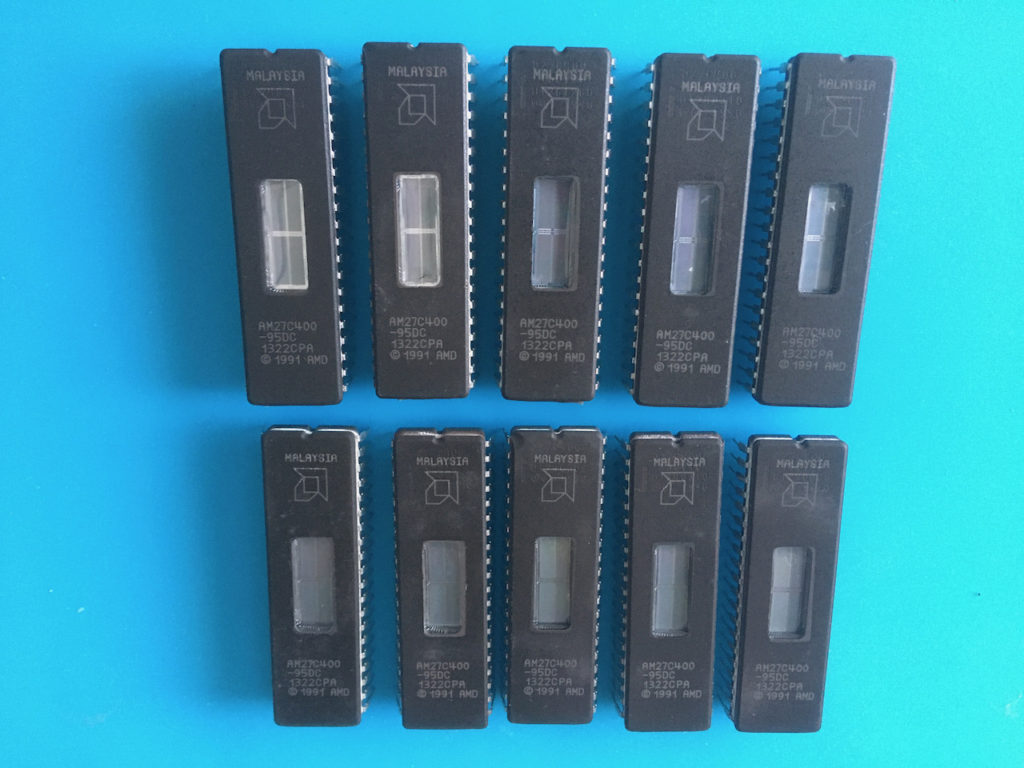
The different manufacturer is usually blatantly obvious when the incorrect manufacturer’s ID is detected by your EPROM programmer. Also, you can often use some Acetone to reveal the genuine original part number.
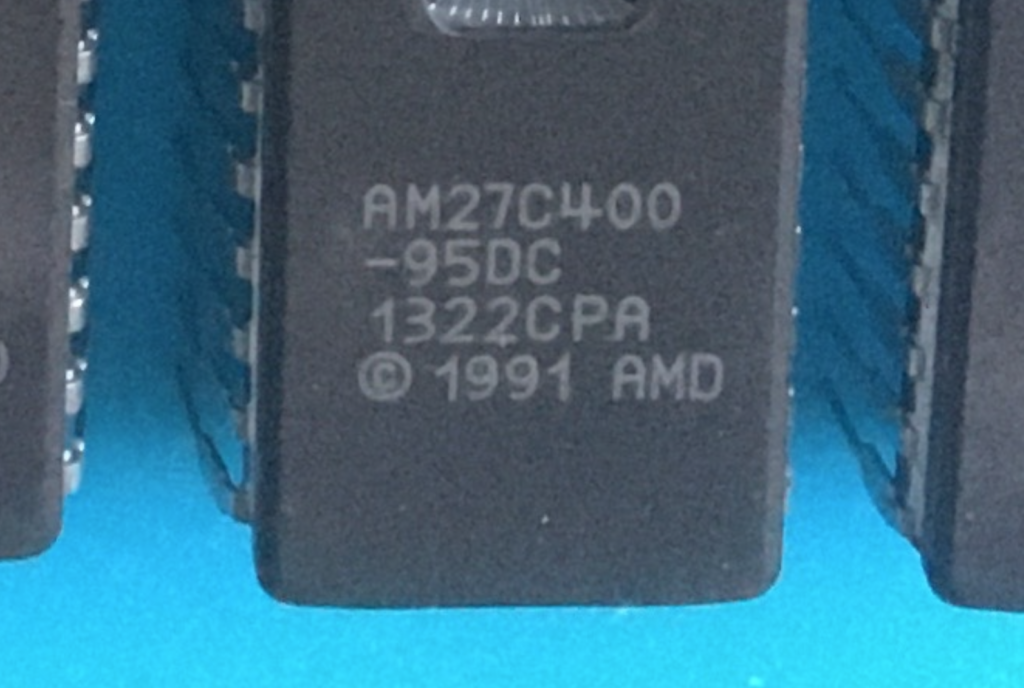
This is where my frustration sometimes turns to degree of anger, when I find that a relatively fast 95ns or a 100ns Access Time marked retro EPROM part (e.g. with a -95 or -10 suffix), actually turns out to be a 150ns (a -15 or -150 suffix), or even slower part.
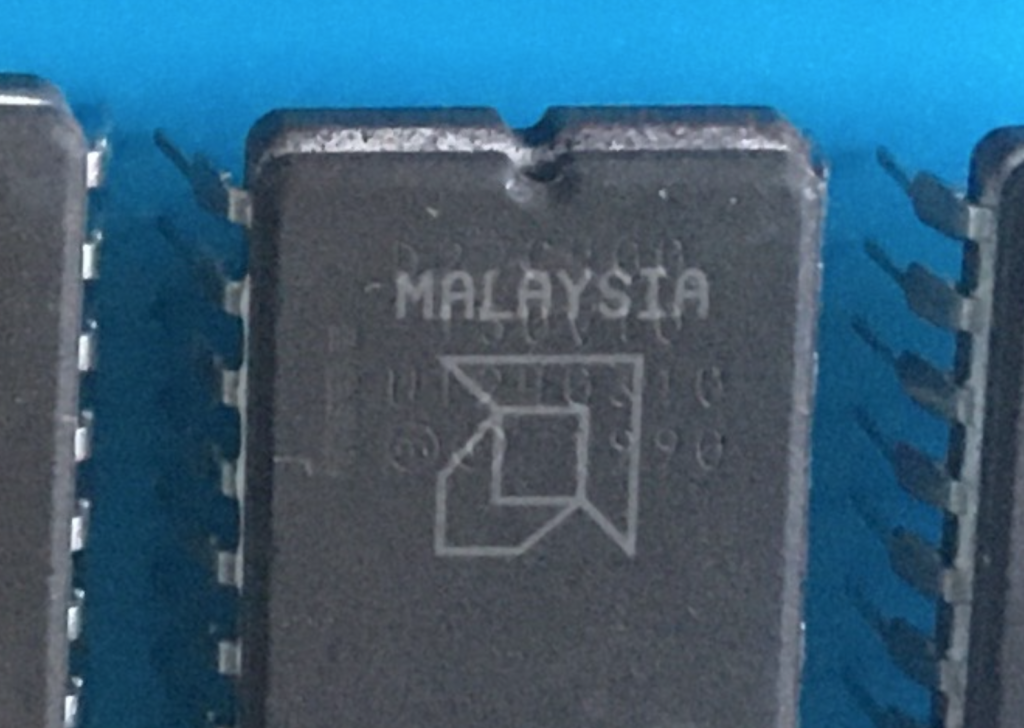
This may not matter, when using the EPROM to repair some retro system where the slower Access Time is still okay.
But, there has been occasions where I have specifically ordered 95ns or 100ns Access Time parts, for a project timing requirement, only to find they were in fact slower re-marked parts.
Latest Re-Marked Chip Frustration
But, now to my latest re-marked chip frustration.
As I’ve been playing around with my old favourite original Motorola MC6809 CPU’s, I thought I’d get myself some Hitachi HD6309 chips. This would then allow me to have a play with some of the enhancements that Hitachi made with the 6309 CPU.
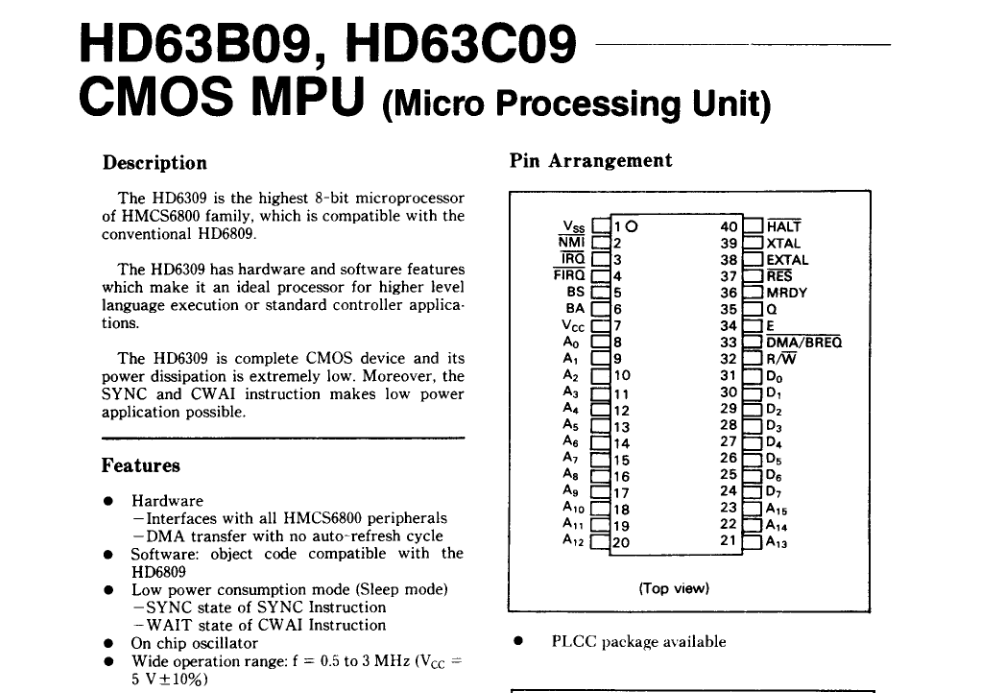
So, I found a supplier on AliExpress and ordered 5 pieces of HD63C09P. I chose the fastest ‘C’ variant, in case I also wanted to experiment with higher clock speeds.

Now, you’ll note these chips are listed as, and pictured as, HD63C09P parts. Specifically, this is the Internal Clock part number, not the ‘E‘ suffixed External Clock variant! Which would be marked as a HD63C09EP.
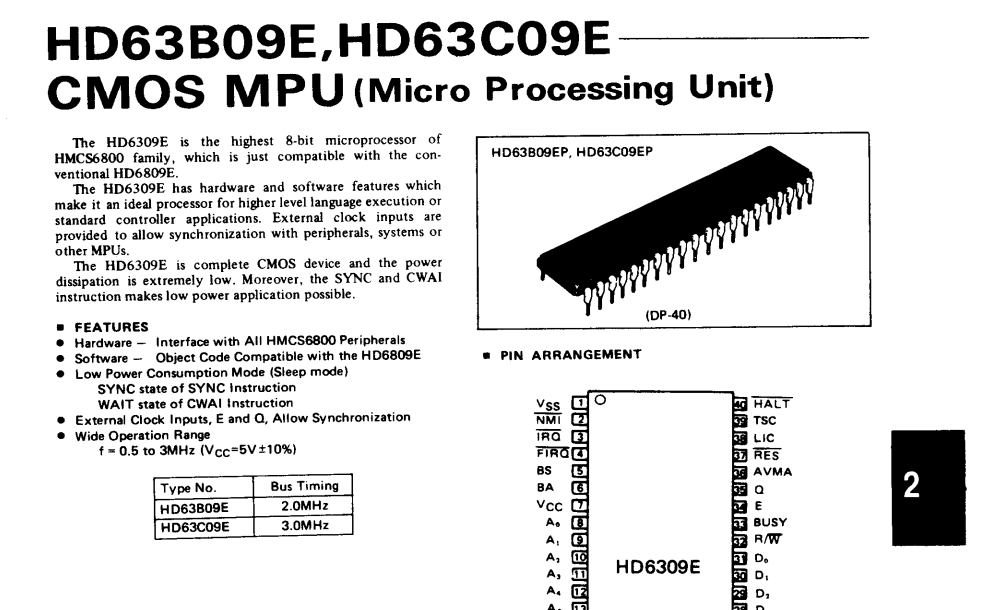
For my intended use, I wanted the original Internal Clock part. The problem is that when buying old 6309 or 6809 CPU’s, which have been recovered by sellers on AliExpress, the reality is that the ‘E‘ External Clock variant is (I’d expect), much more common as a recovered part.
This is because a lot of the produced 6809 systems were based around the MC6883 (or 74LS783, and later 74LS785), Synchronous Address Multiplexor (or SAM) chip, combined with the MC6847 Video Display Generator (VDG).
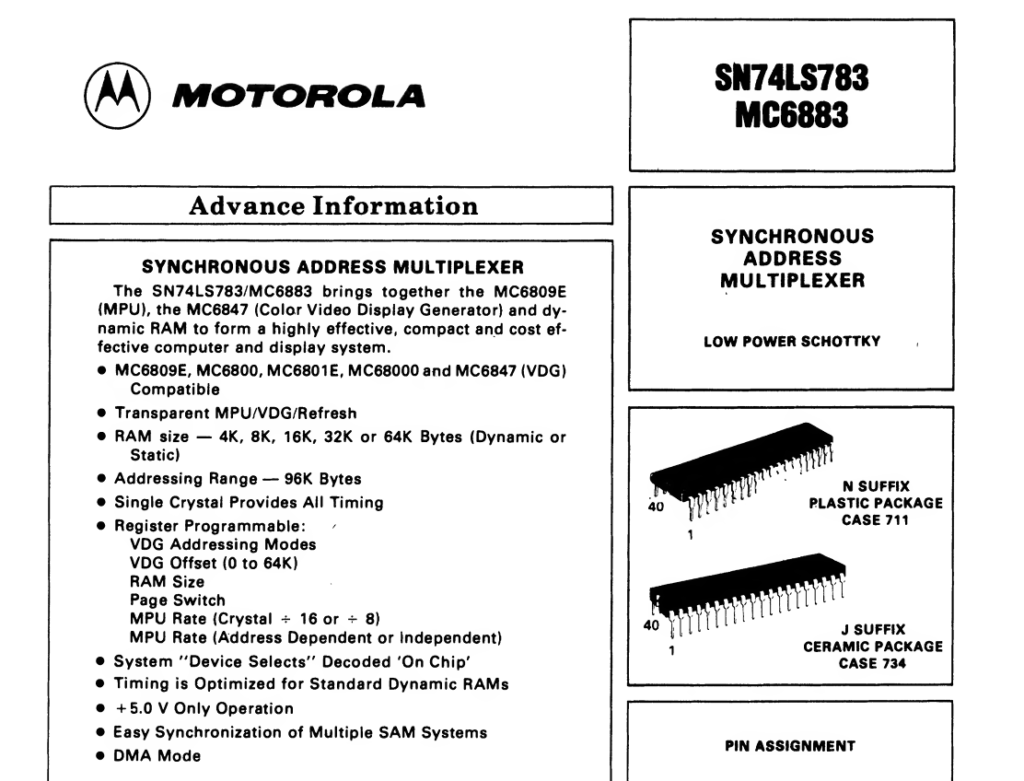
The SAM chip was designed to work with the Externally Clocked 6809E variant. So in a Tandy Colour Computer, or Dragon 32 or 64, you will find a 6809E CPU.
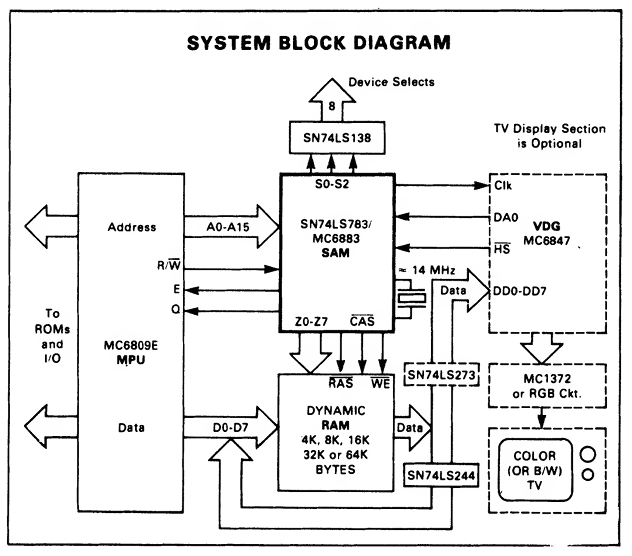
Now I suspect this leads to some recovered 6809 or 6309 chip re-marking problems. I guess, through a lack of AliExpress seller knowledge of the differences, they simply say: “We have a batch of 6309 parts, let’s remark them all as HD63C09P“.
This lack of knowledge about the chips they’re actually dealing with, becomes even more apparent when you look at the AliExpress listing’s item Specification, and you see that they have listed the HD63C09P part as a “Voltage Regulator”!

So, anyway, you can probably see where this story is going…
HD63C09P Chips Arrive
My ordered five pieces of HD63C09P eventually arrived. As advertised, they are all marked as HD63C09P parts.
But, as you’ve probably already guessed, when I swapped each of these out with my old original known working MC6809 CPU chip, my board was dead.
Immediately I knew there was one of two possibilities. Either all 5 chips were DOA, or, these were not HD63C09P chips!
Given what I’ve explained earlier, my first suspicion was that these were actually ‘E‘ suffix chips, incorrectly re-marked.
One of the differences with the External Clock versions is that the E & Q clock signal pins are actually inputs (instead of outputs). Therefore, a quick oscilloscope check of the Q pin confirmed that it was indeed just floating, indicating the pin was most probably an unterminated input.
At this point I referred to the HD63C09E datasheet, to find a circuit for an external clock. My thinking was that I’d just make an external clock circuit, to prove my theory that these were in fact ‘E‘ variant chips. The datasheet provides a relatively simple circuit based on a 74LS76 Dual JK Flip-Flop.
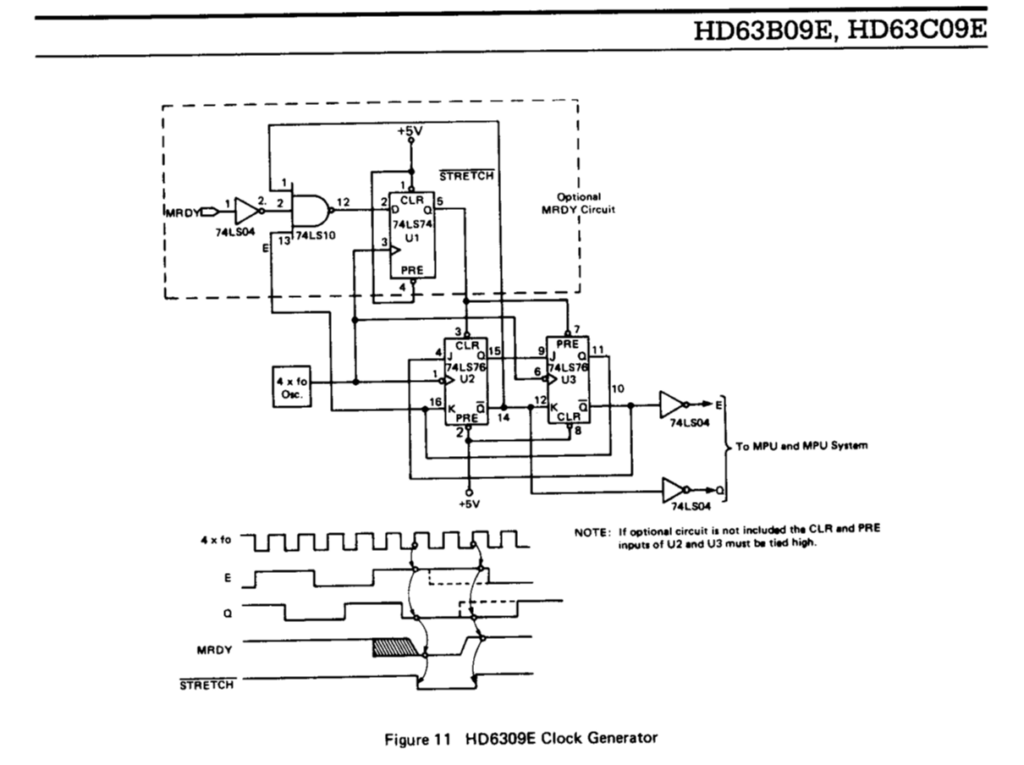
8-Bit Museum NOP CPU Testers
But, then I remembered some simple CPU NOP tester designs, that I’d seen on the 8-Bit Museum website.
You can find the 8-Bit Museum website CPU NOP tester page here.

So I decided now was probably as good a time as any, to order some PCB’s and make some CPU NOP testers. These are a great idea for a very quick and simple CPU chip go / no-go test.
They obviously aren’t a full-proof test of a CPU chip, but by hard-wiring a CPU’s NOP instruction and watching the address bus sequentially count through memory addresses, it’s probably the simplest way of quickly determining if a chip is the CPU it claims to be, and if it is at least running in the most basic of ways.
So the PCB’s arrived. In addition to 6809 and 6809E NOP testers, I also ordered PCBs for the 6800 and 6502 NOP testers.
But for this exercise I first just put together both a 6809 and a 6809E tester.
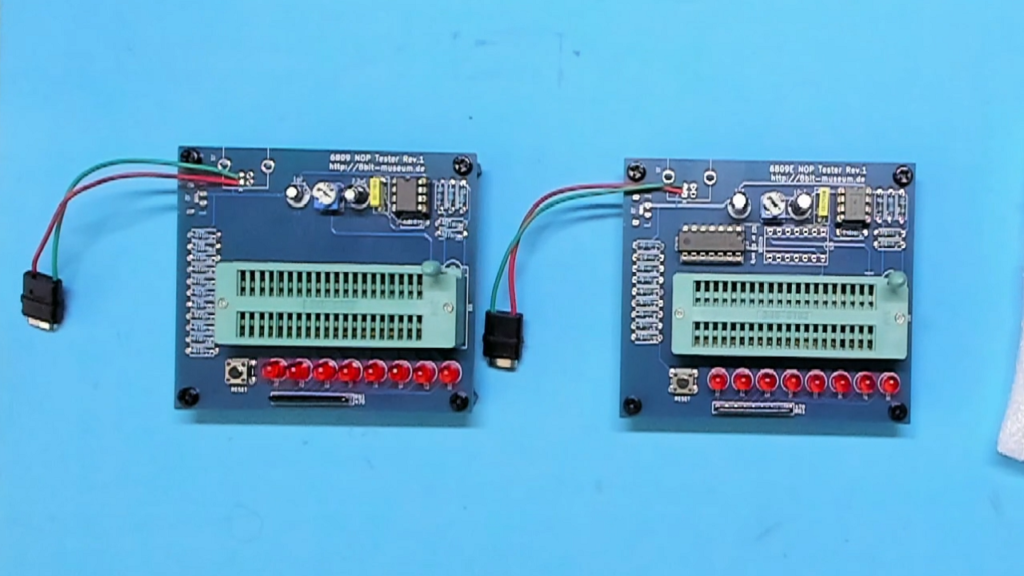
The only change I made is that the PCB’s allow either a USB type B or a Micro-USB socket to be fitted, but I now much prefer USB-C. So, instead, I attached a wired USB-C socket to the PCB’s.
CPU Chip Test
So, with these testers available I was quickly able to test the 6809 NOP tester board with my known good original Motorola MC6809 chips.
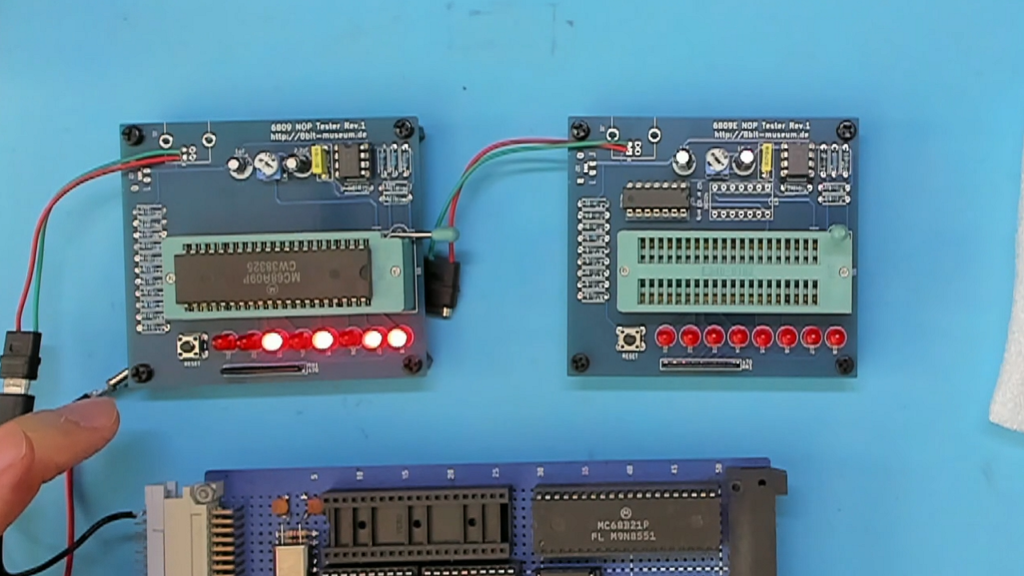
I was also able to verify (once again) that when I inserted the AliExpress marked HD63C09P parts, they were indeed non-functional.
But (surprise surprise), when I put them into the MC6809E NOP tester, we were in business! So, the HD63C09P marked chips are indeed confirmed as actually being ‘E’ suffix variants.
Of course, whether these are actually the claimed higher speed ‘C’ parts remains to be proven. Likewise, whether they are in fact actually Hitachi HD6309 parts also remains to be proven. They could be Motorola MC6809E’s for all I know. When I get some more Acetone, I’ll be sure to give them a rub to see what that reveals.
6809 NOP Tester Technical Points
Now, there are a couple of things I feel I should mention regarding the 8-Bit Museum CPU NOP tester. At least with regard to the 6809 version.
Firstly, I measured the 555 generated clock signal as being around 40Hz. Note, the actual frequency is adjustable via a trimpot. This means that the 6809 is being run at a clock frequency of only around 10Hz (the EXTAL pin input frequency is internally divided by 4). This low operating frequency is obviously notable with the visibly slow count of the address bus LEDs, otherwise if it was operating a lot faster we would have trouble visually distinguishing the binary count progression.
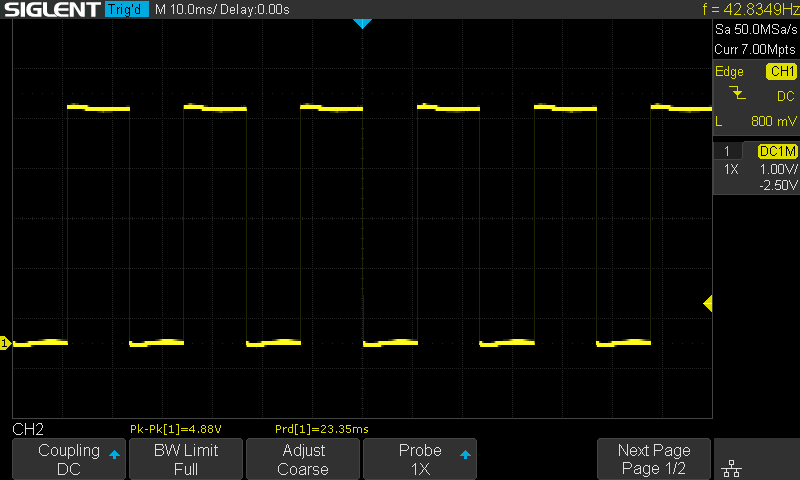
This is interesting because the original Motorola MC6809 chips are HMOS devices, and are therefore fundamentally dynamic parts. The datasheet specifies the minimum crystal frequency as 0.4Mhz (that is, 400KHz). Effectively, a minimum operating clock speed of 100KHz. Below this minimum frequency you would expect operation to be erratic, given that the internal dynamic registers would theoretically be loosing their content.

However, as this tester appears to be working fine with my original Motorola HMOS MC6809 CPUs, I can only assume that the dynamic nature of the part does not effect the Program Counter register, or, the fetching and execution of the NOP instruction (which essentially just increments the Program Counter).
Secondly, and more significantly, the Address Bus pins of the Motorola HMOS MC6809 are rated to sink a maximum of 1.6ma and source a maximum of 400ua. Sufficient for driving up to four LS TTL loads.
The NOP tester uses the CPU’s Address Bus pins to directly drive the LEDs, via 470 ohm resistors. So, allowing for the forward voltage of a Red LED we are sourcing approximately 6ma from each address line pin to drive the LEDs. This is clearly significantly exceeding the CPU’s electrical ratings.
Although we could use low current LEDs with higher resistor values, I’d much rather see a 244 octal buffer between the CPU and the LEDs.
I mention these couple of points as an appropriate level of caution, if you also decide to build yourself one of these 6809 NOP testers.
I’ve also provided these thoughts to the 8-Bit Museum for their consideration. Stephen acknowledged these concerns, but noted that he ran a CPU for several days without breaking it.
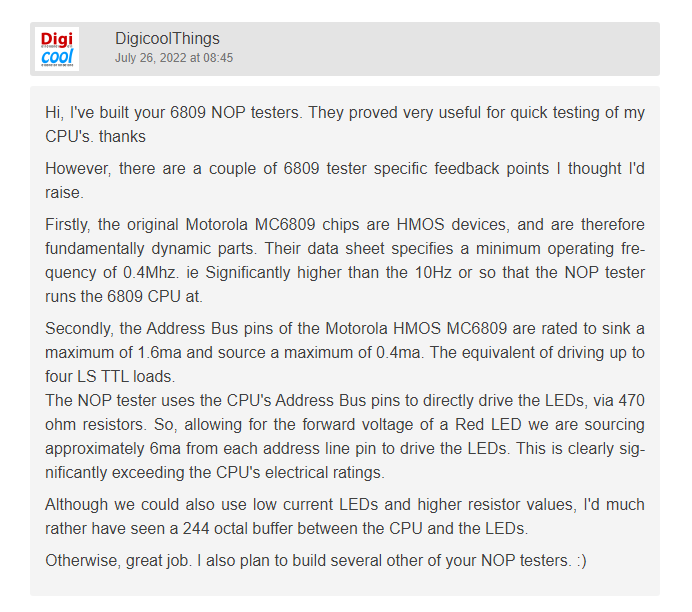

So it is reasonable to expect that for a quick CPU chip NOP test, we will probably be okay. You can see this discussion on the 8-Bit Museum NOP Tester web page.
Summary
To end this story, I’ll also note that I sent a nice message to the AliExpress seller, to inform them of their listing error and to suggest they update their 6309 listing description.
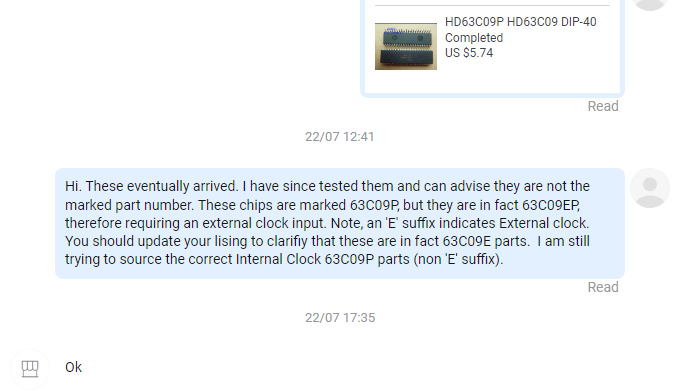
I did get a reply, but it was simply ‘Ok’. The listing hasn’t been updated.
I’d be interested in hearing your experiences with re-marked retro computer chips, in the comments below.
I’d also be keen to hear if anyone has managed to find a supplier, they’ve been able to verify as supplying the correct Internal clock HD63C09P chips!
